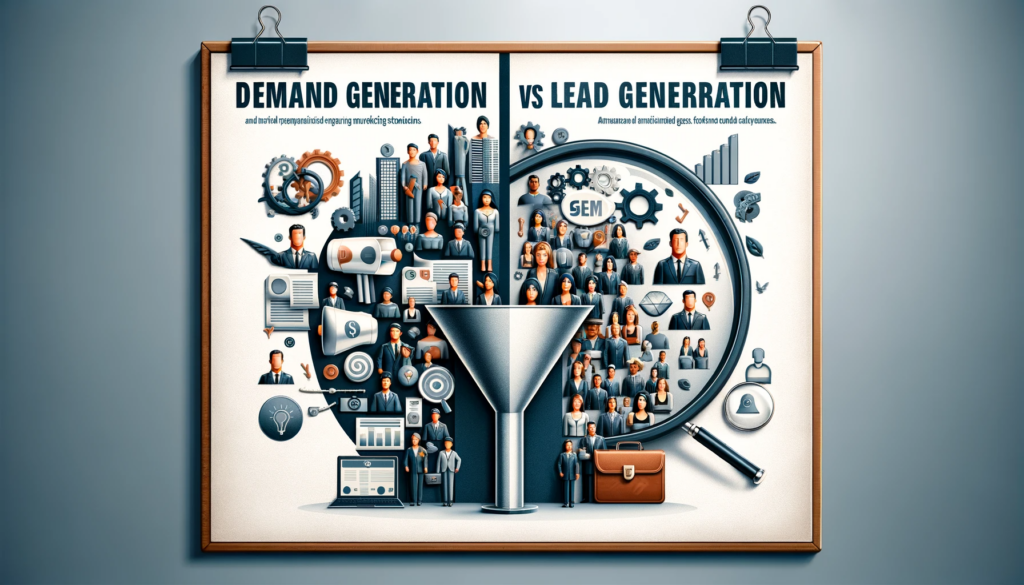In the world of digital marketing, understanding the nuances between demand generation and lead generation is crucial for driving successful business outcomes.
This article will delve into the distinct concepts of demand generation and lead generation, shedding light on their individual significance and the role they play in the modern marketing landscape.
We will begin by clarifying the concept of demand generation, highlighting its importance in creating and sustaining customer interest. Subsequently, we will explore lead generation, elucidating the ways in which it differs from demand generation and examining its pivotal role in capturing potential customer information.
The interplay between content marketing and demand generation will also be explored, offering insights into the types of content that can effectively fuel demand generation efforts. In addition, we will delve into the realm of inbound marketing and its relationship with lead generation, uncovering the diverse strategies that can be harnessed to attract and convert leads. This article will provide valuable guidance on measuring success in demand generation and lead generation, outlining the key metrics that should be tracked to gauge the effectiveness of each strategy.
We will discuss the synergistic potential of combining demand generation and lead generation strategies, aiming for optimal results in driving business growth. By the end of this article, readers will have gained a comprehensive understanding of demand generation and lead generation, along with practical insights into how these two marketing disciplines can be strategically leveraged for business success. So, let’s dive into the world of demand generation and lead generation to unlock their potential for your marketing endeavors.
Key Takeaways:
Demand generation focuses on creating awareness and interest in a product or service, while lead generation focuses on converting that interest into potential customers. Both demand generation and lead generation are crucial for driving sales and revenue for a business. Effective content marketing and inbound marketing strategies play a significant role in both demand generation and lead generation.
Understanding Demand Generation and Lead Generation
Understanding Demand Generation and Lead Generation is crucial for businesses looking to create effective sales and marketing strategies that resonate with their target audience.
Demand generation focuses on creating interest and awareness in potential customers, whilst lead generation involves capturing and nurturing these potential leads into actual customers. By comprehending these concepts, businesses can tailor their marketing efforts to attract and engage their ideal customers effectively.
Implementing strategic demand and lead generation tactics is a key driver for business growth and revenue generation, as it enables companies to consistently attract and convert prospects into loyal customers. Understanding these concepts is instrumental in developing personalised and targeted marketing campaigns, ultimately enhancing brand visibility and market positioning.
What is Demand Generation?
Demand Generation is the process of creating a need and generating interest in a particular product or service within the target audience, ultimately leading to increased sales and revenue for the business.
Why is Demand Generation Important?
Demand Generation is important as it forms the foundation for effective lead generation, allowing businesses to strategically target and engage potential leads, ultimately leading to customer acquisition and increased sales.
This process involves creating and nurturing a demand for products or services amongst the target audience by employing various marketing strategies and technologies. By leveraging B2B marketing methodologies, businesses can effectively segment their audience and tailor their messaging to generate interest and drive action.
The use of Clearbit technology enables businesses to gain valuable insights into their target market, enableing them to craft personalised and targeted demand generation campaigns, thereby maximising their reach and impact.
What is Lead Generation?
Lead Generation refers to the process of identifying and capturing potential customers based on their demonstrated interest in a product or service, as well as their potential to become paying customers.
How is Lead Generation Different from Demand Generation?
Lead Generation focuses on identifying potential customers and capturing their interest, whilst Demand Generation aims to create that interest and need within the audience in the first place, setting the stage for lead generation efforts.
Lead generation involves actively seeking out prospects, often through targeted marketing efforts, and nurturing them into potential customers. On the other hand, demand generation employs various strategies to raise brand awareness, educate the audience about products or services, and stimulate their interest, eventually leading to a higher demand for the offerings.
Effective content plays a crucial role in both lead and demand generation. Quality, relevant content can attract and engage potential leads and create demand by addressing customer pain points and providing solutions. In B2B marketing, strategies such as account-based marketing and personalised outreach can significantly impact the success of both lead and demand generation efforts.
The Role of Content Marketing in Demand Generation

Credits: Ultrajeb.Com – Lawrence Hall
Content Marketing plays a pivotal role in demand generation by creating valuable and relevant content that resonates with the target audience, driving audience interest and setting the stage for further engagement and lead capture.
What Types of Content Can Be Used for Demand Generation?
Various types of content, such as informative blogs, engaging videos, and interactive initiatives, can be utilised for demand generation to capture audience interest, drive brand awareness, and facilitate effective B2B marketing campaigns.
Informative blogs (like this one…ha) serve as a valuable resource for addressing industry-specific pain points, offering insights, and establishing thought leadership, ultimately attracting professionals seeking relevant information. On the other hand, engaging videos contribute to enhancing audience engagement, delivering compelling narratives, and showcasing product functionalities in a visually appealing manner. Moreover, interactive initiatives like webinars and virtual events promote direct interaction, enabling real-time conversations and networking opportunities, thus fostering deeper connections with potential clients.
The Role of Inbound Marketing in Lead Generation

Credits: Ultrajeb.Com – Samuel Rodriguez
Inbound Marketing serves as a powerful strategy for lead generation by attracting potential leads through informative and valuable content, leveraging social media, and optimising performance to drive effective lead response and customer acquisition.
What Types of Inbound Marketing Strategies Can Be Used for Lead Generation?
Inbound Marketing strategies such as content optimisation, social media engagement, and performance tracking can be effectively utilised for lead generation, driving strong lead response and customer acquisition for businesses.
Content optimisation involves creating valuable, relevant content that resonates with the target audience and attracts organic traffic to the website, subsequently leading to increased lead capture. Similarly, leveraging social media platforms for engagement and interactions with prospects can significantly enhance brand visibility and generate quality leads.
Diligent performance tracking enables businesses to analyse the effectiveness of their marketing efforts and make data-driven decisions to refine their lead generation strategies.
Measuring Success: Metrics for Demand Generation and Lead Generation
Measuring success in demand generation and lead generation requires the evaluation of key metrics such as:
- Customer acquisition cost
- Social media engagement
- CRM integration
- The AIDA model
- Metrics like CPA, CAC, MQL, SQL, and ABM to gauge the effectiveness of marketing initiatives
What Metrics Should be Tracked for Demand Generation?
Metrics such as customer acquisition cost, social media reach, CRM utilisation, and the application of the AIDA model, along with CPA, CAC, MQL, SQL, and ABM, are critical for tracking the success of demand generation initiatives and refining marketing strategies.
These metrics play a pivotal role in evaluating the effectiveness of various marketing efforts. Understanding customer acquisition cost (CAC) aids in determining the investment required to acquire a new customer, while social media reach enables businesses to gauge their outreach and engagement. CRM utilisation offers valuable insights into customer relationship management efficiency. Implementing the AIDA model fosters a better understanding of customer journey stages, contributing to more targeted strategies.
Additionally, CPA (Cost Per Acquisition), MQL (Marketing Qualified Lead), SQL (Sales Qualified Lead), and ABM (Account-Based Marketing) are fundamental elements in assessing campaign performance and refining customer acquisition tactics.
What Metrics Should be Tracked for Lead Generation?
The tracking of metrics such as customer acquisition cost, social media impact, CRM integration, and the application of the AIDA model, including CPA, CAC, MQL, SQL, and ABM, is vital for evaluating the success of lead generation strategies and optimising marketing performance.
Customer Acquisition Cost (CAC) is a key metric that measures the average cost of acquiring a new customer. It helps businesses understand the efficiency of their marketing efforts and the resources required to convert leads into customers. Social media impact, on the other hand, provides insights into the effectiveness of social media campaigns in generating leads and engaging with potential customers.
CRM integration plays a crucial role in lead generation as it allows businesses to centralise customer data, track interactions, and personalise marketing efforts. The AIDA model, focusing on Awareness, Interest, Desire, and Action, guides the lead nurturing process and helps in converting prospects into customers.
Combining Demand Generation and Lead Generation Strategies for Optimal Results

Credits: Ultrajeb.Com – Zachary Williams
The combination of demand generation and lead generation strategies enables businesses to utilise insights from audience interactions, implement effective tactics and campaigns, use technology such as B2B marketing tools and Clearbit, and optimise performance for comprehensive lead generation success.
Conclusion: Which is More Important, Demand Generation or Lead Generation?
Both demand generation and lead generation are crucial for business success, with demand generation creating the initial interest and need, and lead generation capturing and converting that interest into potential leads and eventual customer acquisition.
Each plays a vital role in nurturing prospects through the sales funnel, with demand generation laying the foundation for generating awareness and lead generation converting this awareness into tangible opportunities.
A successful demand generation strategy leverages various channels such as content marketing, social media, and events to engage and educate potential buyers, thereby positioning the brand as a trusted industry authority.
On the other hand, effective lead generation strategies often utilise targeted outreach, personalised messaging, and lead scoring mechanisms to identify and qualify prospects ready for sales engagement, contributing to a higher conversion rate and faster sales cycle.
Frequently Asked Questions
What is the difference between demand generation and lead generation?
Demand generation refers to the marketing strategies and tactics used to create awareness and generate interest in a company’s products or services, while lead generation focuses on identifying and attracting potential customers and converting them into leads for future sales opportunities.
Which one is more important for a business: demand generation or lead generation?
Both demand generation and lead generation are crucial for a business’s success. Demand generation drives overall brand awareness and creates a pool of potential customers, while lead generation helps turn those potential customers into qualified leads that can be nurtured into becoming paying customers.
What are some common demand generation tactics?
Some common demand generation tactics include content marketing, social media marketing, email marketing, search engine optimisation (SEO), and events and webinars.
What are some common lead generation strategies?
Common lead generation strategies include targeted advertising, landing pages, forms and CTAs, lead magnets, and lead nurturing campaigns.
How do demand generation and lead generation work together?
Demand generation and lead generation are closely interconnected. Demand generation creates awareness and interest, which generates leads for the lead generation efforts. In turn, lead generation tactics provide the needed data and insights to refine and improve demand generation efforts.
What skills are necessary for successful demand generation and lead generation?
Successful demand generation and lead generation require a combination of skills, including strong communication and networking skills, an understanding of target audiences and their behaviours, data analysis and tracking abilities, and knowledge of various marketing channels and tactics.


